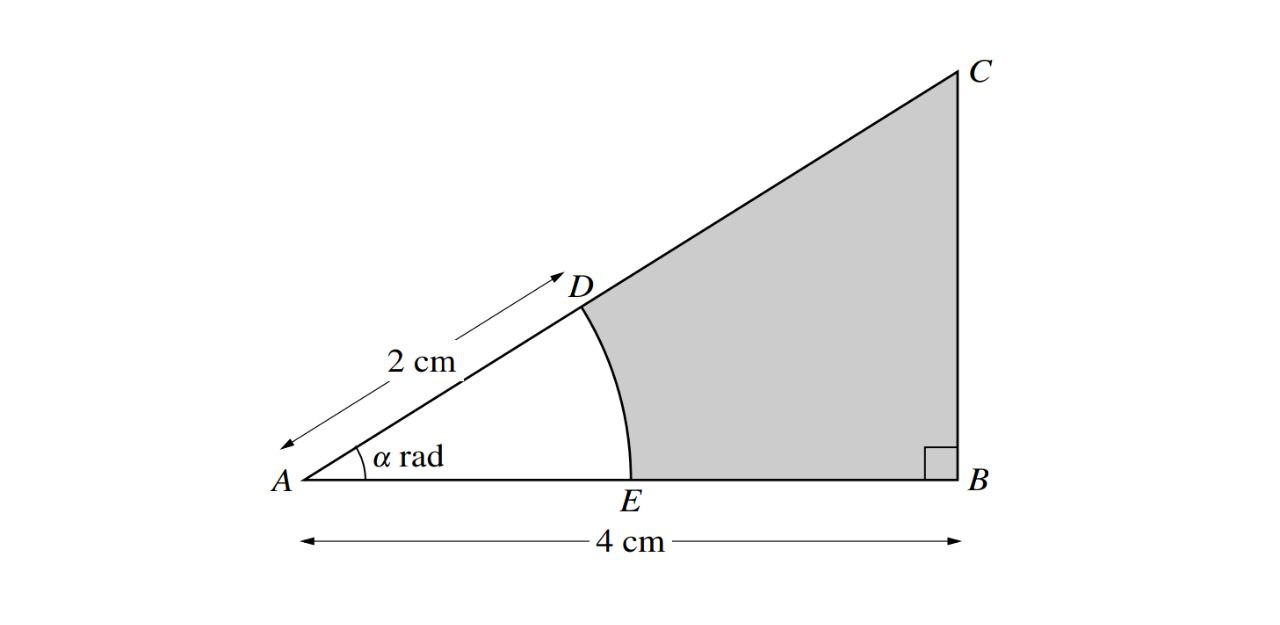Question
A piece of wire of length 24cm is bent to form the perimeter of a sector of a circle of radius r cm.
(i)Show that the area of the sector ,\(Acm^{2}\) is given by \(A=12r-r^{2}\)
(ii)Express A in the form \(a-\left ( r-b \right )^{2}\),where a and b are constants.
(iii)Given that r can vary,state the greatest value of A and find the corresponding angle of the sector.
▶️Answer/Explanation
(i) Show that the area of the sector \(A\) is given by \(A = 12r – r^2\)
The perimeter of the sector is the length of the wire, which is equal to the sum of the arc length and the two radii.
\( \text{Perimeter} = \text{Arc Length} + 2r \)
Since the arc length is a fraction of the total circumference (which is \(2\pi r\)), we can express the arc length as \(\frac{\theta}{360} \times 2\pi r\), where \(\theta\) is the central angle of the sector.
So, we have the equation:
\( 24 = \frac{\theta}{360} \times 2\pi r + 2r \)
\( \theta = \frac{360}{\pi} (24 – 2r) \)
\( A = \frac{\theta}{360} \times \pi r^2 \)
\( A = \frac{360}{\pi} (24 – 2r) \times \frac{\pi}{360} \times \pi r^2 \)
\( A = (24 – 2r)r = 12r – r^2 \)
(ii) Express \(A\) in the form \(a – (r – b)^2\), where \(a\) and \(b\) are constants:
\( A = 12r – r^2 \)
\( A = -(r^2 – 12r + 36) + 36 \)
\( A = -(r – 6)^2 + 36 \)
So, \(A\) can be expressed in the form \(a – (r – b)^2\) with \(a = 36\) and \(b = 6\).
(iii) Given that \(r\) can vary, state the greatest value of \(A\) and find the corresponding angle of the sector:
The expression \(-(r – 6)^2 + 36\) indicates that \(A\) is maximized when \((r – 6)^2\) is minimized, which occurs when \(r = 6\). So, the greatest value of \(A\) is \(36\), and it occurs when \(r = 6\).
\( \theta = \frac{360}{\pi} (24 – 2r) \)
Substitute \(r = 6\):
\( \theta = \frac{360}{\pi} (24 – 2(6)) = \frac{360}{\pi} \times 12 \)
So, the corresponding angle \(\theta\) is \(120^\circ\).
Therefore, the greatest value of \(A\) is \(36\) square centimeters, and the corresponding angle of the sector is \(120^\circ\).
Question
The line with gradient -2 passing through the point P(3t,2t)intersects the x-axis at A and the y-axis at B.
(i)Find the area of triangle AOB in terms of t.
(ii)The line through P perpendicular to AB intersects the x-axis at C.
Show that the mid-point of PC lies on the line y=x.
▶️Answer/Explanation
(i) Find the area of triangle \(AOB\) in terms of \(t\):
Given the equation \(y – 2t = -2(x – 3t)\), we can simplify it to \(y + 2x = 8t\).
The x-intercept (\(A\)):
– Set \(y = 0\): \(0 + 2x = 8t\)
– Solve for \(x\): \(x = 4t\)
– So, the coordinates of \(A\) are \((4t, 0)\).
The y-intercept (\(B\)):
– Set \(x = 0\): \(y + 2(0) = 8t\)
– Solve for \(y\): \(y = 8t\)
– So, the coordinates of \(B\) are \((0, 8t)\).
Now, the area of triangle \(AOB\) is given by the formula:
\( \text{Area} = \frac{1}{2} \times \text{base} \times \text{height} \)
In this case, the base is the distance between points \(A\) and \(B\), which is \(4t\), and the height is the y-coordinate of \(B\), which is \(8t\).
\( \text{Area} = \frac{1}{2} \times 4t \times 8t = 16t^2 \)
So, the area of triangle \(AOB\) is \(16t^2\).
(ii) The line through \(P\) perpendicular to \(AB\) intersects the \(x\)-axis at \(C\).
The slope of the line AB is the negative reciprocal of the slope of the line passing through P:
\(m_{AB} \cdot m_{PC} = -1\)
\((-2) \cdot m_{PC} = -1\)
\(m_{PC} = \frac{1}{2}\)
Now, the line through P with slope \(\frac{1}{2}\) has the equation in point-slope form:
\(y – 2t = \frac{1}{2}(x – 3t)\)
\(y = \frac{1}{2}x + \frac{5}{2}t\)
When this line intersects the \(x\)-axis (\(y = 0\)), we can find point C:
\(0 = \frac{1}{2}x + \frac{5}{2}t\)
\(x = -5t\)
This gives us the coordinates of point C as \((-5t, 0)\).
Now, the mid-point of PC is the average of the x-coordinates and y-coordinates:
\(M\left(\frac{-5t + 3t}{2}, \frac{0 + 2t}{2}\right)\)
\(M(-t, t)\)
To show that this point lies on the line \(y = x\), we can check if \(y = x\) for these coordinates:
\(t = -t\)
This is true, so the mid-point of PC, \(M(-t, t)\), lies on the line \(y = x\).
Question

The diagram shows triangle ABC in which AB is [perpendicular to BC .The length of AB is 4cm and angle CAB is \(\alpha\) radians.The arc DE with cent6re A and radius 2cm meets AC at D and AB at E .Find in terms of \(\alpha \)
(i)the area of the shaded region.
(ii)the perimeter of the shaded region.
Answer/Explanation
(i)Area \(\Delta =\frac{1}{2}\times 4\times 4\tan \alpha \)
Area Sector\(=\frac{1}{2}\times 2^{2}\alpha \)
Shaded area \(=8\tan \alpha -2\alpha \)
(ii)\(DC=\frac{4}{\cos \alpha }-2\)
arc DE=\(2\alpha\)
Perimeter =\(\frac{4}{\cos \alpha }+4\tan \alpha +2\alpha\)